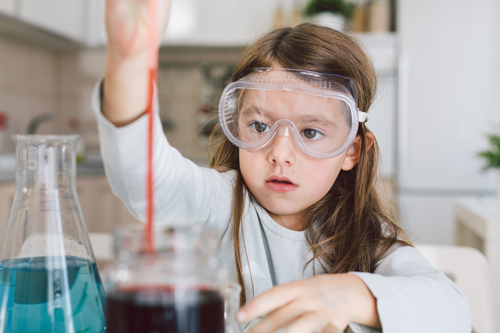|
With children out of school for the time being, many parents are looking for ways to help them continue learning at home. Sometimes, you don’t have to look further than your kitchen.
There are a number of fun and engaging science experiments you can do with just some basic kitchen ingredients. It is an easy way to keep your child curious about the world around them and a great way to spend some quality time together as well. Here are three ideas to try.
1. Grow a Carrot Top
Growing a carrot top is a simple but educational activity that will let your child observe how plant leaves develop and teach them some basic responsibility.
All you need to do is cut the top off a carrot, about 2 to 3 cm from the stem, and place it in a shallow dish. Have your child pour a small amount of water into the dish, just enough to submerge the base of the carrot top. Place the dish in a sunny location and, in just a couple of days, green leaves will start to grow from the top.
Encourage your child to check the water level every day and top it up if needed. Have them record their observations as well, such as how long it takes for the leaves to sprout and how quickly they grow.

2. Grow Sugar Crystals
Growing sugar crystals at home is a great way to demonstrate how crystals grow in nature. All you need is water, sugar, a glass jar, and a piece of cotton string.
Prepare your string by tying it to the middle of a pencil, a knife, or any other similar object. Next, bring a pot of water just to a boil and begin stirring in sugar one spoonful at a time. Continue adding sugar until it does not dissolve any more, which means your solution is saturated. You can also add a few drops of food colouring to create colourful crystals.
Pour the solution into the jar, preferably without getting any of the undissolved sugar into it as well. Suspend your cotton string from the top of the jar so that it dangles in the liquid without touching the sides.
Set the jar somewhere it can remain undisturbed and, after a few days, you should start seeing crystal growth on the string. Once the crystals are as large as desired, you can pull the string out. The crystals are 100% edible.
3. Create a Density Rainbow
Another easy experiment involving sugar and food colouring, this is a fantastic visual demonstration of solution density. To begin, line up five glasses and fill four of them with half a cup of water. Then, add 1 tablespoon of sugar to the first glass, 2 tablespoons to the second, 3 tablespoons to the third, and 4 tablespoons to the fourth. Put a few drops of different food colouring in each and stir until the sugar is fully dissolved.
Using a baster, transfer some of the water with the most dissolved sugar into the empty glass. Rinse the baster and fill it with the next solution, then slowly and carefully squeeze it out on top of the first layer of liquid. The two solutions should remain separate due to their different densities. Do this for the two remaining solutions to create a colourful rainbow.
Children are naturally curious, and they can continue to learn a lot at home. Keep your child engaged with their learning and teach them a thing or two about biology or chemistry with a kitchen science experiment you can enjoy doing together.
|